OR/14/043 Site description - Nant Peris: Difference between revisions
m 1 revision imported |
|
(No difference)
| |
Latest revision as of 08:17, 5 April 2016
| Farr, G, Graham, J, and Stratford, C. 2014. Survey, characterisation and condition assessment of Palustriella dominated springs 'H7220 Petrifying springs with tufa formation (Cratoneurion)' in Wales. British Geological Survey Internal Report, OR/14/043. |
Introduction
The eight upland ‘petrifying springs’ at Nant Peris have been surveyed and monitored both by Lewis, (2003)[1] and more recently by Creer, (2012)[2] as part of SAC monitoring for H7220. They represent the highest altitude sites visited as part of this survey (681–689 maOD). The most recent survey (Creer, 2012[2]) concluded that ‘two out of eight springs had increased in extent since 2003, six had contracted in size and two were unknown, with only one of the eight springs concluded to be in favourable condition mainly due to the presence of negative indicator species namely grasses and Epilobium brunnescens. During this survey only a selection of the springs were assessed and they include springs No. 1, 4 and 7 (comparable with the IDs used for the SAC monitoring). The sites survey was undertaken with Julie Creer (NRW). There was no evidence of tufa depsoitsion at either springs 1, 4 or 7.
Geological and hydrogeological data
All of the springs are located in an area underlain by strata from the ‘Bedded Pyroclastic Formation’ from the Ordovician Snowdon Volcanic Group. There are large boulders and in situ bedrock within the area of the springs, the rocks were tested with HCI and were not carbonaceous. The Bedded Pyroclastic Formation (BP) is up to 450 m thick however despite its name pyroclastic elements form only a small part of the formation with basaltic tuffaceous sediments, hyaloclastites and basic tuffites abundant in places (Howells et al 1991). Analysis of a bedrock sample, collected near the survey site is also provided by Howells et al 1991 (Sample Reference KB801 Cwm Idwal 6398, 5868) and shows that the bedrock is dominated by silicates (44.91%). Peat, till and head deposits are mapped in the area however the majority of land at this altitude and on the exposed hillside comprises of bedrock.
| % weight | |
| SiO2 | 44.91 |
| Al2O3 | 14.9 |
| TiO2 | 2.08 |
| FeO | 12.17 |
| MgO | 10.92 |
| CaO | 5.98 |
| Na2O | 3.78 |
| K2O | 0.53 |
| MnO | 0.18 |
| P2O5 | 0.24 |
| LOI | 4.30 |
| Total | 99.99% |
The general direction of groundwater and surface water flow is most likley to be topgraphically driven, downslope from NE to SW. Sites 1, 4 and 7 were surveyed and at each site it was possible to trace a small runnel than fed into the upslope side of the ‘spring’ and then continued on the downslope side. The runnels at all sites generally had a very low flow of water 0.2–0.2 l/s.
Based on this observation one could question the classification of these sites (1, 4 and 7) as true ‘springs’ as mounds tend to be located ‘midway’ along established, although small runnels rather than in an area where one would identify a true spring. There was no evidence of tufa deposition at or nearby the mounds and classification of this site as petrifying (tufa depositing) should be avoided.
The processes or controls that lead to the formation of these mounds are not known, and Sites 1, 4 and 7 appeared to be in various stages of development. Site 1 is fed by a small runnel to the north and also perhaps seepage from the base of the bedrock outcrop, the mound looks intact and is 0.48 m in thickness, measured from the competent base to the surface of the Palustriella mat. Site 4 appears to have experienced a collapse in the lower (or frontal) part of the mound and it is possible that this collapse will propagate backwards.
Two water quality samples were collected at Sites 1 and 7. Both samples are weekly mineralised as would be expected at high elevation in a hardrock aquifer. pH values are neutral 7.04 and 7.24 and all the ions are in low levels perhaps indicating a young water recently derived from rainfall. Sample NP1.1 has no dominant water facies and sample NP7.1 is trending towards weak calcium bicarbonate type water. Nutreint levels are all low or below levels of detection. The water would not be described as rich in either calcium (15.1–26 mg/l) or bicarbonate (15–67.7 mg/l) both of which were towards the lowest levels for any samples within this study.
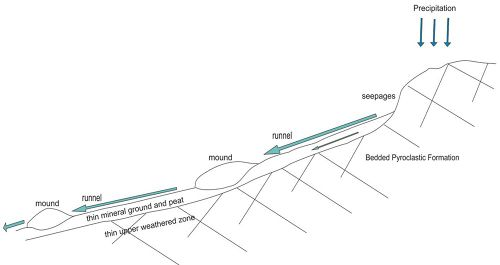
Land use and pressures
The area surrounding the mounds is heavily grazed by sheep and also used by walkers. There is no evidence of poaching or burning within the general area and while the surrounding acid grassland and bog shows signs of overgrazing by sheep, the areas of Palustriella vegetation show little or no signs of poaching. There are no properties nearby and thus no evidence of any private water supplies or sewage systems within 500 m. It is not thought that there are any hydrological pressures within close proximity to the sites. The greatest threat may come from grazing animals or walkers.
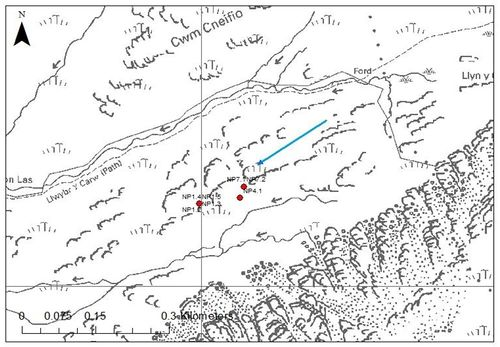
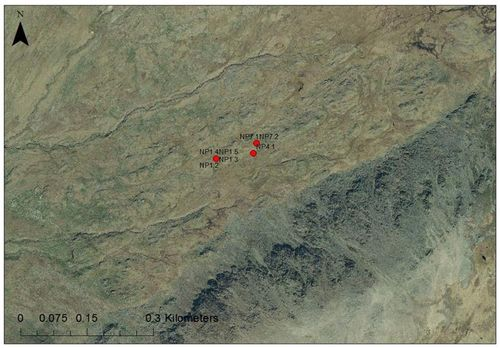


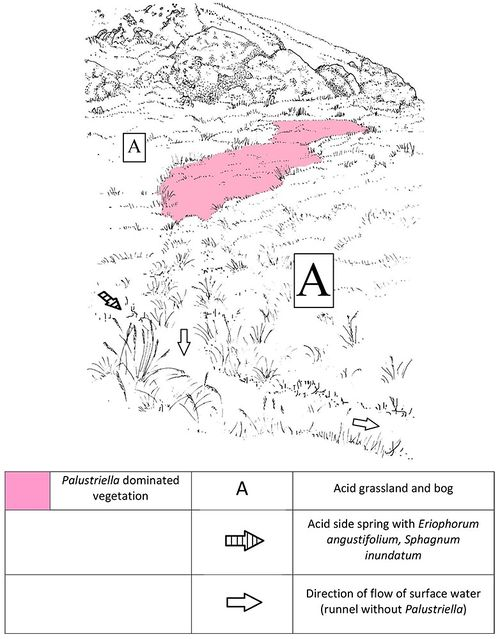

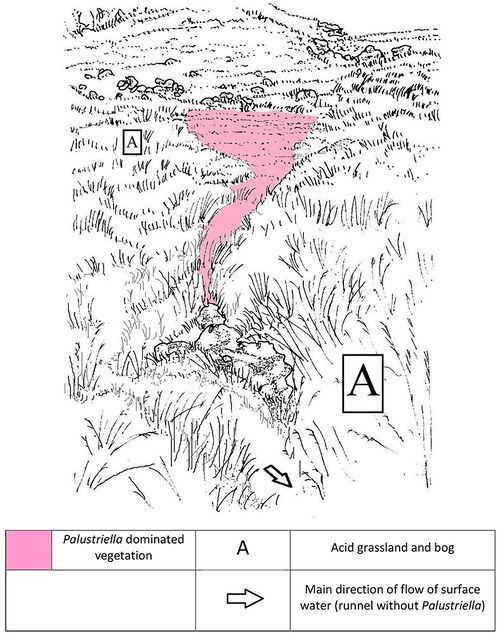
Vegetation (spring) for Nant Peris Site 1
Nant Peris Site 1 corresponds with Spring No 1 on existing NRW surveys. It comprises flushed vegetation associated with upland springs on open hills at altitude (c. 600 maOD, Snowdon range) exclusively dominated by Palustriella falcata forming dome shaped floating mats of vegetation above spring water. A number of vascular plants are prominent including Montia fontana, Saxifraga sp. and the invasive alien Epilobium brunescens. A number of typical Palustriella associated bryophytes occur (i.e those typically associated with base-rich water) including Crataneron filicinum, Campylium stellatum, Scorpidium revolvens, Fissidens adianthoides, Bryum pseudotriquetrum, Scorpidium, scorpioides, Philonotis fontana but also a number of less markedly calcicole species (Rhizomnium punctatum, Brachythecium rivulare). These last two species are not unusual within upland flushes (and indeed were recorded in small quantity from a number of other sites during this survey). However, the presence of Straminergon stramineum (a marked calcifuge) in good quantity mixed with Palustriella falcata and Brachythecium rivulare is exceptional.
| Agrostis stolonifera | R (<1%) |
| Aneura pinguis | F |
| Brachythecium rivulare | O |
| Bryum psudotriquetrum | R |
| Calliergonella cuspidata | R |
| Campylium stellatum | R |
| Cardamine pratensis | R |
| Carex demissa | R |
| Carex flacca | O |
| Cirsium palustre | R (<1%) |
| Cratoneuron filicinum | O |
| Epilobium brunescens | O |
| Eriophorum angustifolium | R |
| Festuca ovina | R |
| Fissidens adianthoides | O |
| Juncus acutiflorus | R |
| Montia fontana | O |
| Palustriella falcata | A |
| Philonotis fontana | R |
| Rhizomnium puntatum | R |
| Rhytidiadelphus squarosus | R |
| Ricardia mutifida | O |
| Saxifraga stellaris | R |
| Scorpidium revolvens | O |
| Scorpidium scorpioides | R |
| Straminergon stramineum | O |
Vegetation (adjoining spring) for Nant Peris 1
Acid grassland (dominated by Nardus stricta) with regular boggy vegetation (Polytrichum commune, Polytrichum strictum and Sphagnum species).
| Camplopus atrovirens | R |
| Carex binervis | R |
| Cladonia portentosa | O |
| Cladonia uncialis | R |
| Erica tetralix | R |
| Huperzia selago | R |
| Juncus squarrosus | F |
| Nardus stricta | O |
| Polytrichum commune | R |
| Polytrichum strictum | R |
| Racomitrium lanuginosum | R |
| Rhytidiadelphus loreus | O |
| Sphagnum capillifolium ssp. rubellum | R |
| Sphagnum inundatum | R |
| Sphagnum papillosum | O |
| Thuidium tamaraiscinum | R |
Vegetation (spring) for Nant Peris Site 2
Nant Peris Site 2 corresponds with Spring No. 4 on existing NRW surveys. It also comprises flushed vegetation associated with upland springs on open hills at altitude (c. 600 maOD, Snowdon range) exclusively dominated by Palustriella falcata forming dome shaped floating mats of vegetation above spring water. A number of vascular plants are prominent includimg Montia fontana, Saxifraga sp. the invasive alien Epilobium brunescens as well as occasional Selaginella selaginoides at the margins. A number of typical Palustriella associated bryophytes occur (i.e those typically associated with base-rich water) including Crataneron filicinum, Campylium stellatum, Scorpidium revolvens, Bryum pseudotriquetrum, Scorpidium, scorpioides and Philonotis fontana. The presence of Straminergon stramineum (a marked calcfuge) in good quantity mixed with Palustriella falcata and Brachythecium rivulare however is exceptional.
| Agrostis stolonifera | R (<1%) |
| Aneura pinguis | F |
| Brachythecium rivulare | O |
| Bryum psudotriquetrum | R |
| Campylium stellatum | R |
| Cardamine pratensis | F |
| Carex demissa | O |
| Carex flacca | O |
| Cratoneuron filicinum | O |
| Epilobium brunescens | F |
| Eriophorum angustifolium | O |
| Festuca ovina | O |
| Festuca rubra | R |
| Juncus acutiflorus | O |
| Montia fontana | O |
| Palustriella falcata | A |
| Philonotis fontana | O |
| Rhytidiadelphus squarosus | R |
| Saxifraga stellaris | O |
| Scorpidium revolvens | O |
| Selaginella selaginoides | R |
| Straminergon stramineum | O |
Vegetation (adjoining spring) for Nant Peris Site 2
Acid grassland (dominated by Nardus stricta, Juncus squarrosus) with regular boggy vegetation (Polytrichum commune, Sphagnum species and occasional Pteridium, Huperzia selago).
| Camplopus atrovirens | R |
| Carex binervis | O |
| Galium saxatile | O |
| Huperzia selago | R |
| Hylocomium slpendens | O |
| Juncus squarrosus | F |
| Nardus stricta | F |
| Polygala serpyllifolia | R |
| Polytrichum commune | R (<1%) |
| Potenilla erecta | O |
| Pteridium aquilinum | R (<1%) |
| Racomitrium lanuginosum | R |
| Sphagnum capillifolium ssp. rubellum | R |
| Sphagnum inundatum | R (<1%) |
| Sphagnum papillosum | O |
| Sphagum tenellum | R |
| Thuidium tamarscinum | R (<1%) |
Vegetation (spring) for Nant Peris 3
Flushed vegetation associated with upland springs on open hills at altitude (c. 600 maOD, Snowdon range) exclusively dominated by Palustriella falcata forming dome shaped floating mats of vegetation above spring water. A number of vascular plants are prominent including Montia Fontana and Saxifraga sp. A number of typical Palustriella associated bryophytes occur (i.e those typically associated with base-rich water) including Crataneron filicinum, Fissidens adianthoides, Campylium stellatum, a non fertile Chilosyphos sp., Scorpidium revolvens, Bryum pseudotriquetrum, Scorpidium, scorpioides, Philonotis Fontana but also a number of less markedly calcicole species (Rhizomnium punctatum, Plagiomnium undulatum, Brachythecium rivulare). The presence of Straminergon stramineum (a marked calcfuge) in good quantity mixed with Palustriella falcata and Brachythecium rivulare is exceptional.
| Agrostis stolonifera | R |
| Aneura pinguis | O |
| Brachythecium rivulare | R |
| Bryum psudotriquetrum | R |
| Calliergonella cuspidata | R |
| Campylium stellatum | R |
| Cardamine pratensis | O |
| Carex demissa | R |
| Carex flacca | O |
| Chilosyphos sp. | R |
| Cratoneuron filicinum | O |
| Ctenidium molluscum | R |
| Festuca ovina | R |
| Fissidens adianthoides | R |
| Juncus acutiflorus | O |
| Montia fontana | O |
| Palustriella falcata | A |
| Philonotis fontana | R |
| Plagiomnium undulatum | R |
| Prunella vulgaris | R (<1%) |
| Rhizomnium puntatum | R |
| Rhytidiadelphus squarosus | R |
| Ricardia mutifida | R |
| Saxifraga stellaris | R |
| Scorpidium revolvens | O |
Vegetation (adjoining spring) for Nant Peris 3
Acid grassland (dominated by Nardus stricta, Juncus squarrosus, Carex binervis) with regular boggy vegetation (Polytrichum commune, Sphagnum species and occasional Camplyopus atrovirens).
| Camplopus atrovirens | R |
| Carex binervis | R |
| Juncus squarrosus | F |
| Nardus stricta | O |
| Polygala sepyllifolia | R |
| Polytrichum commune | R |
| Racomitrium lanuginosum | R |
| Sphagnum capillifolium ssp. rubellum | R |
| Sphagnum inundatum | R |
| Sphagnum papillosum | O |
| Thuidium tamariscinum | R |
| Rhytidiadelphus loreus | R |
| Veronica officinalis | R |
Condition assessment
The 3 sites surveyed are included within the Eryri SAC 2007–2012 monitoring cycle (Creer, 2012)[2]. Only one of eight sites was recorded as having a favourable conservation status, the others being classed as unfavourable principally on the basis of the presence of the invasive alien Epilobium brunescens.
The three sites surveyed (SAC Sites 1, 4 and 7) very small sites (<5 x 5 square metres) and appear susceptible to loss through natural vegetation succession. Site observations found evidence of a number of similar features that previously supported flush vegetation and likely Palustriella. In addition, SAC monitoring of vegetation extent for the period 2003–2012 noted that individual sites changed both positively and negatively with regard to extent. However there is little information on the hydrological factors that may allow for the formation of these sites.
Of the 3 sites surveyed, the Palustriella dominated vegetation of Sites 1 and 2 had occasional to frequent cover of Epilobium brunescens. Consequently, following Eryri SAC monitoring guidance (based on Common Standards monitoring), Nant Peris (Sites 1 and 2) should be classified as being in unfavourable ecological status (in relation to vegetation) and Nant Peris (Site 3) should be classified as being in favourable ecological status (in relation to vegetation).
All three Nant Peris sites should be classified as being in good hydrological condition.
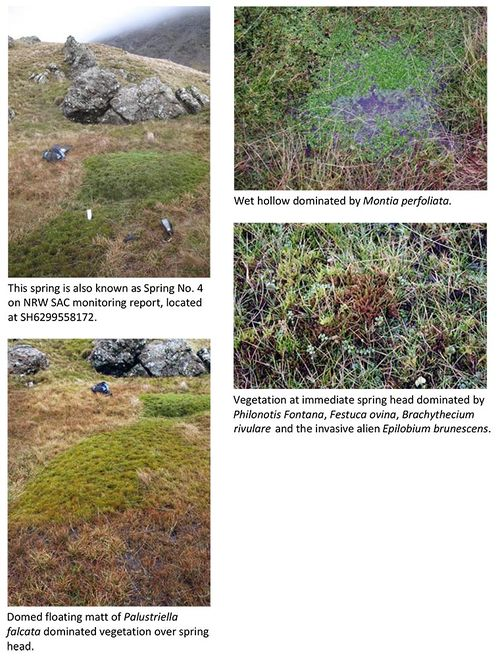
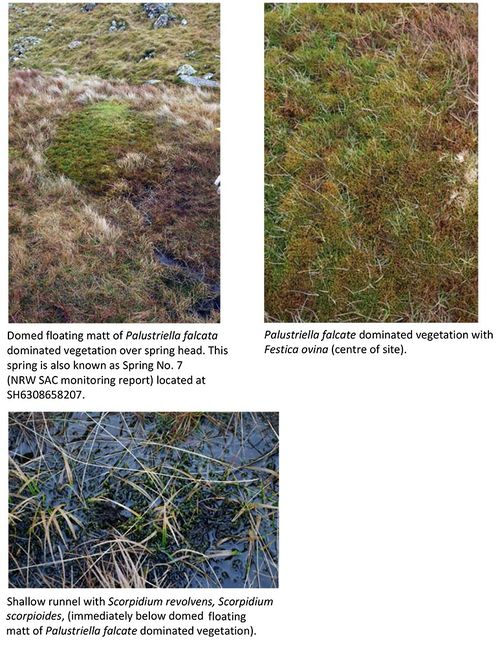
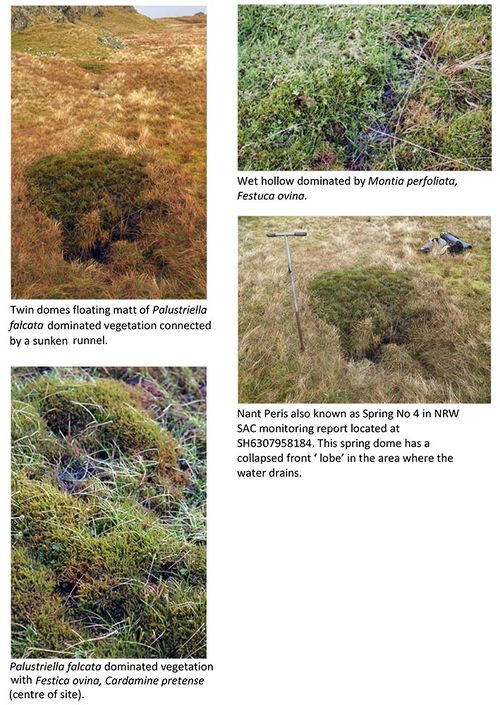
References
- ↑ LEWIS, H. 2003. Eryri SAC petrifying springs with tufa formation (Cratoneurion) monitoring report. CCWinternal report. CCW Bangor.
- ↑ 2.0 2.1 2.2 CREER, J. 2012. Eryri SAC &220: petrifying springs with tufa formation (Cratoneurion. Draft SAC) monitoring report. CCW internal report. CCW Bangor.
- ↑ HOWELLS, M F, REEDMAN, A J, and CAMPBELL, S D G. 1991. Orodovician (Caradoc) marginal basin volcanism in Snowdonia (north-west Wales). London HMSO for the British Geological Survey.